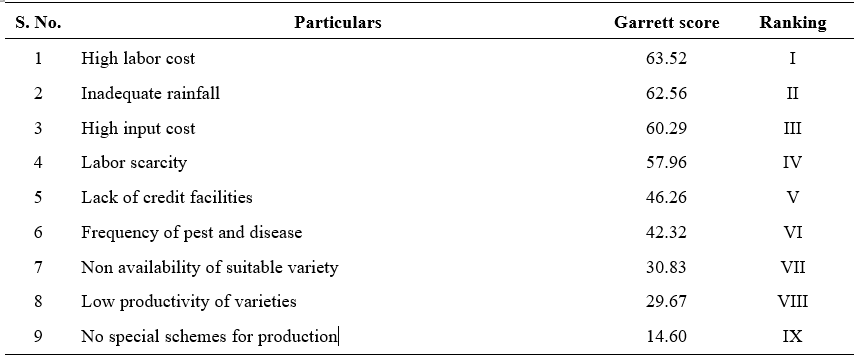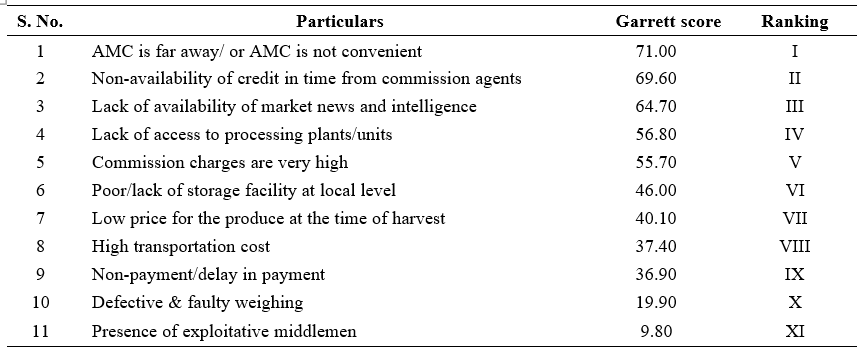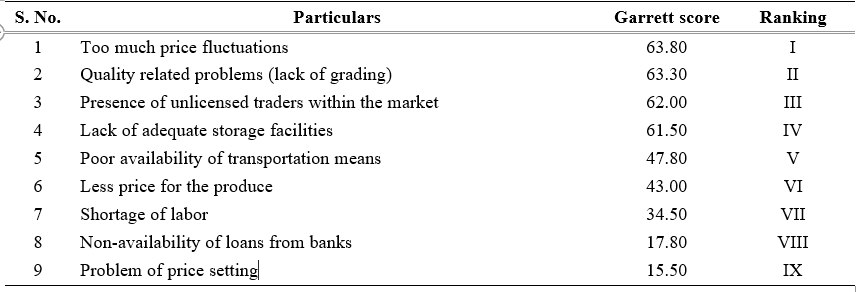Constraints Faced by Different Stakeholders Involved in Value Chain of Black Gram in Bapatla District of Andhra Pradesh
0 Views
K. THANUSHA*, V. SITARAMBABU, B. APARNA AND K.N. SREENIVASULU
Institute of Agribusiness Management, S.V. Agricultural College, ANGRAU, Tirupati – 517 502
ABSTRACT
The present study focuses on major constraints related to production and marketing of black gram faced by farmers and intermediaries involved in value chain in Bapatla district of Andhra Pradesh. Primary data was collected through survey method from various categories of farmers and intermediaries. The results indicated that high labor cost was the major problem expressed by farmers in black gram production. In marketing, price fluctuations, underutilization of dal mills, competition from fellow retailers were the major constraints faced by commission agents/ traders, dal millers, retailers and wholesalers..
KEYWORDS: Value chain, constraints, stakeholders, black gram.
INTRODUCTION
Black gram (Vigna mungo (L.) Hepper) is one of the important pulse crop of kharif season or as rice fallow pulse crop in our country. India is the largest producer, consumer and also the largest importer of pulses in the world. It contributes for about 31 per cent of world area and 28 per cent of world production of pulses. Out of total food grain production of 315.7 million tons, pulses account for 25.46 million tons in India and constitute 8 per cent of the total food grain production in 2021-22 . In India, total land under pulses cultivation is 28.78 M ha. Andhra Pradesh is one of the major black gram producing states in India. Black gram was grown in an area of 3.93 lakh ha with a production of 3.65 lakh tons and productivity was 929 kg ha-1 (Indiastat.com 2021- 22). In Bapatla district it is grown in area of 26,629 ha with a production of 37,031 tons and productivity was 1343 kg ha-1 (District Hand Book of Statistics Bapatla, 2022). Key actors involved in value chain of black gram are producers, traders, commission agents, wholesalers and retailers. The added value of this paper is that not only are the problems identified but they have been ranked to allow for prioritization of interventions for dealing with such constraints. To identify the problems in the value chains, a pre-tested questionnaire was designed separately for identifying constraints at producer level, as well as other stakeholders involved in black gram value chain.
MATERIAL AND METHODS
The present study was conducted in Bapatla district of Andhra Pradesh with specific objective of identifying the constraints faced by value chain players in black gram. Based on highest area and production of black gram, three mandals namely Nagaram, Amarthalur, Cherukupalle were selected by purposive sampling method and from each mandal two villages were selected namely Allaparu, Pedamatlapudi from Nagaram mandal, Amarthalur, Inturu from Amarthalur mandal and Arumbaka, Rambhotlapalem from Cherukupalle mandal. From each village 15 farmers were selected by random sampling technique, thus making a total of 90 farmers. Personal interviews were conducted with growers belonging to different strata and marketing intermediaries like traders(six), commission agent(six), processors(six), wholesalers(six), and retailers(six) with specially designed questionnaire. A total of 30 market intermediaries were selected through snowball sampling technique.
Garrett ranking technique was used to study the opinions of the respondents regarding the factors that acted as constraints faced by the farmer and value chain players. The per cent position of each rank was found out by following equation.

where,
Rij = Rank given for the ith items by the jth individual
and
Nj = Number of items ranked by the jth individual.
By referring to the Garrett’s table, the percent positions estimated were converted into scores. Thus, for each factor the scores of the various respondents were added and the mean values were estimated. The mean values thus obtained for each of the attributes were arranged in descending order. The attributes with the highest mean value were considered as the most important one and the others followed in the order.
RESULTS AND DISCUSSIONS
Perceived Constraints Faced by Farmers in Value Chain of Black gram
It is clearly seen from garrett scores presented in the Table 1 that at the production level the greatest challenge faced by farmers was high labour cost (63.52), while inadequate rainfall (62.56) for prolonged periods of time reported as second major constraint in the production of black gram. Many of the farmers also complained about high input cost (60.29) where in several farmers cannot even afford to purchase the quantity required to increase the production of black gram, labor scarcity (57.96), lack of credit facilities (46.26) and frequency of pest and disease (42.32) were the major constraints in black gram production. Some farmers also quoted about non availability of suitable variety (30.83), low productivity of varieties (29.67) and no special schemes for production (14.60) as minor constraints.
The marketing constraints faced by the black gram farmers are presented in Table 2. The farmers complained about the lack of access to APMCs (71) as they are far away.
Many of the farmers also complained about non availability of credit in time from banks, money lenders (69.60) due to which they are not able to meet their urgent requirements. Lack of availability of market news (64.70), lack of access to processing units (56.80) due to majority of farmers sold their produce to the nearby traders at the village level, high cost towards commission agents (55.70), lack of storage facilities
(46) poses as important constraints in marketing. Some minor constraints quoted by farmers were low price for produce (40.10), high transportation cost (37.40), delay in payment (36.9), faulty weighments (19.90) and presence of exploitative middle man (9.80).
The farmers encountered many problems in value chain of black gram. Looking to this, there is a need to strengthen extension activities for improving package of practices in the study area.
Perceived Constraints Faced by Other Stakeholders in Value Chain of Black gram
Among the list of constraints (Table 3) faced by the commission agents/traders, price fluctuations (63.80) were the major constraint that affected their businesses. Poor quality of produce (63.30), unlicensed traders (62), lack of storage facilities (61.50) were other major constraints faced by them. The traders also reported poor availability of transportation (47.80), less price for the produce in the market (43), shortage of labor (34.50), non-availability of loans (17.80) and problem of price setting (15.50) as other constraints. The dal millers (Table 4) in the study area reported that underutilization of their plants (63.10) as the greatest challenge. This
Table 1. Farmers perception on constraints in production of produce

Table 2. Farmers perception on constraints in marketing of produce

occurs due to the lack of timely availability of raw material from the farmers/traders. And other constraints were transportation bottlenecks (61.80), illegal traders in market (54.30), power shortage (50.50), poor quality of produce (35.30), shortage of labor (34) and lack of capital (9.83). The details of constraints faced by the wholesalers and retailers are mentioned in the Table 5. The table revealed that competition from fellow retailers (63) was the major constraint to them which ranks first followed by price condition in the market for procurement (48.6), high storage cost (47.5), high brokerage charges (44.3), price fluctuations in the market for value-added produce (43.75), wastage and spoilage losses (35.3) and high transportation cost (26.3) were other constraints which had a greater impact on the margins received by them.
The black gram value chain is complex and diversified. The involvement of various stakeholders and flow of main products and by-products produced through processing made the value chain a complex diversified network. The products traced along the value chain are un-husked split dal, dehusked whole dal, dehusked split dal were studied in detail which was more profitable to the stakeholders. As the value chain of black gram is complex and diversified in the study area, still there are so many opportunities exist for other value-added products and sophisticated foods. Hence, there is a need to encourage research in food processing sector to produce innovative ready-to-eat products by using black gram in the study area and export these products rather than exporting the raw material. By developing
Table 3. Constraints of trader and commission agent while purchasing produce from farmers

Table 4. Perception on constraints faced by processor while processing of produce into value added products

Table 5. Wholesaler/wholesaler-cum-retailer/retailer perception on constraints faced in their business in marketing of value-added products of black gram

efficient market linkages that connect farmers with traders, processors and end consumers directly, farmers will be able to get better price for their produce and by investing in establishment of processing units that can produce value added products of pulses enhances the marketability of the products.
LITERATURE CITED
District Hand Book of Statistics Bapatla. 2022. Government of Andhra Pradesh. Bapatla, Andhra Pradesh. 60-65.
Ganesh, S., More, M.S., Rathod, V.J., Bagde, N.T and Suryawanshi, S.N., 2023. Marketing of black gram and constraints faced by farmers in production and marketing of black gram in Washim District.
IndiaStat. 2022. Area, production and productivity of pulses in India. Retrieved from the website(https:// www.indiastat.com) on 21.6.2023.
Kumari, M and Singh, R.G. 2016. Production and marketing of chickpea in Bihar: Problems and prospects for the farmers. International Journal of Agricultural Science and Research. 6(3): 125-136.
Kumar, K., Bhatia, J and Kumar, M. 2018. Constraints in the production and marketing of pulses in Haryana. International Journal of Pure & Applied Bioscience. 6(2): 1309-1313.
Laitha, A. 2020. Pulses Value Chain Analysis in Myanmar. Myanmar Economic Bulletin. 2(2):21-43.
Morey, S.R., Sale, Y.C., Kulkarni, A.R and Dongre, C.S. 2015. Economics of marketing and problems of red gram in Solapur district. Trends in Biosciences. 8(23): 6593-6599.
Perke, D.S., Puri, R.V and Nagargoje, S.R. 2017. Constraints in production and marketing of soybean in Hingli district of Maharashtra. Bulletin of Environment, Pharmacology and Life Sciences. 6(3): 61-63.
Reddy, G.S., Kumar, D.P and Reddy, T.N. 2018. A study on marketing problems of paddy and bengal gram farmers with special reference to Kurnool district, Andhra Pradesh. International Journal of Management, Technology and Engineering. 8(6): 579-587.
- Bio-Formulations for Plant Growth-Promoting Streptomyces SP.
- Brand Preference of Farmers for Maize Seed
- Issues That Consumer Experience Towards Online Food Delivery (Ofd) Services in Tirupati City
- Influence of High Density Planting on Yield Parameters of Super Early and Mid Early Varieties of Redgram (Cajanus Cajan (L.) Millsp.)
- Influence of Iron, Zinc and Supplemental N P K on Yield and Yield Attributes of Dry Direct Sown Rice
- Effect of Soil and Foliar Application of Nutrients on the Performance of Bold Seeded Groundnut (Arachis Hypogaea L.)

